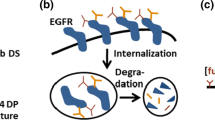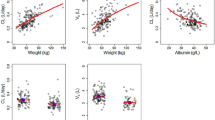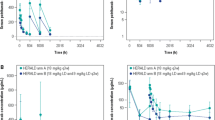Abstract
Purpose
Vactosertib, a novel inhibitor of transforming growth factor-β type Ι receptor, is under development for the treatment of various cancers. The objective of this study was to characterize the population pharmacokinetics of vactosertib in patients with solid tumors.
Methods
Vactosertib population pharmacokinetics was assessed by nonlinear mixed-effects modelling of plasma concentration–time data obtained from a first-in-human phase 1 trial conducted in patients with advanced solid tumors. The final population pharmacokinetic model was constructed by assessing the effect of covariates on pharmacokinetic parameters including demographic characteristics, laboratory values, hepatic and renal function, and concomitant medications. The robustness of the final model was evaluated using a bootstrap method as well as visual predictive check based on Monte Carlo simulations and goodness-of-fit plots.
Results
A total of 559 concentrations from 29 patients were available for pharmacokinetic analysis. A two-compartment linear model with first-order absorption and absorption lag time adequately described the population pharmacokinetics of vactosertib. The estimates of apparent clearance (CL/F) and volume of central compartment (Vc/F) were 31.9 L/h (inter-individual variability, 0.481) and 82.9 L (inter-individual variability, 0.534), respectively. The mixture model accounts for both typical absorption profile in the majority of patients and distinct profile in some patients with uncommon gastrointestinal conditions. Body mass index was significantly associated with Vc/F.
Conclusions
The model developed in this study adequately describes the population pharmacokinetics of vactosertib in patients with advanced solid tumors. The pharmacokinetic characteristics assessed using the model would provide useful quantitative information to assist the future clinical development of vactosertib.



Similar content being viewed by others
References
Jin CH, Krishnaiah M, Sreenu D, Subrahmanyam VB, Rao KS, Lee HJ, Park S-J, Park H-J, Lee K, Sheen YY, Kim D-K (2014) Discovery of N-((4-([1,2,4]Triazolo[1,5-a]pyridin-6-yl)-5-(6-methylpyridin-2-yl)-1H-imidazol-2-yl)methyl)-2-fluoroaniline (EW-7197): a highly potent, selective, and orally bioavailable inhibitor of TGF-β type I receptor kinase as cancer immunotherapeutic/antifibrotic agent. J Med Chem 57(10):4213–4238. https://doi.org/10.1021/jm500115w
Akhurst RJ, Hata A (2012) Targeting the TGFβ signalling pathway in disease. Nat Rev Drug Discov 11(10):790
Derynck R, Akhurst RJ, Balmain A (2001) TGF-β signaling in tumor suppression and cancer progression. Nat Genet 29(2):117
Yang L, Pang Y, Moses HL (2010) TGF-β and immune cells: an important regulatory axis in the tumor microenvironment and progression. Trends Immunol 31(6):220–227
Kim MJ, Park SA, Kim CH, Park SY, Kim JS, Kim DK, Nam JS, Sheen YY (2016) TGF-beta type I receptor kinase inhibitor EW-7197 suppresses cholestatic liver fibrosis by inhibiting HIF1alpha-induced epithelial mesenchymal transition. Cell Physiol Biochem 38(2):571–588. https://doi.org/10.1159/000438651
Son JY, Park SY, Kim SJ, Lee SJ, Park SA, Kim MJ, Kim SW, Kim DK, Nam JS, Sheen YY (2014) EW-7197, a novel ALK-5 kinase inhibitor, potently inhibits breast to lung metastasis. Mol Cancer Ther 13(7):1704–1716. https://doi.org/10.1158/1535-7163.mct-13-0903
Yoon JH, Jung SM, Park SH, Kato M, Yamashita T, Lee IK, Sudo K, Nakae S, Han JS, Kim OH, Oh BC, Sumida T, Kuroda M, Ju JH, Jung KC, Park SH, Kim DK, Mamura M (2013) Activin receptor-like kinase5 inhibition suppresses mouse melanoma by ubiquitin degradation of Smad4, thereby derepressing eomesodermin in cytotoxic T lymphocytes. EMBO Mol Med 5(11):1720–1739. https://doi.org/10.1002/emmm.201302524
Keedy VL, Bauer TM, Clarke JM, Hurwitz H, Baek I, Ha I, Ock C-Y, Nam SY, Kim M, Park N, Kim JY, Kim S-J (2018) Association of TGF-β responsive signature with anti-tumor effect of vactosertib, a potent, oral TGF-β receptor type I (TGFBRI) inhibitor in patients with advanced solid tumors. Journal of Clinical Oncology 36(15_suppl):3031. https://doi.org/10.1200/jco.2018.36.15_suppl.3031
Powell J, Gobburu J (2007) Pharmacometrics at FDA: evolution and impact on decisions. Clin Pharmacol Ther 82(1):97–102
Food, Administration D (2003) Exposure-response relationships–study design, data analysis, and regulatory applications. Guidance for Industry
Lee JY, Garnett CE, Gobburu JV, Bhattaram VA, Brar S, Earp JC, Jadhav PR, Krudys K, Lesko LJ, Li F (2011) Impact of pharmacometric analyses on new drug approval and labelling decisions. Clin Pharmacokinet 50(10):627–635
Samara E, Granneman R (1997) Role of population pharmacokinetics in drug development. A pharmaceutical industry perspective. Clin Pharmacokinet 32(4):294–312. https://doi.org/10.2165/00003088-199732040-00003
Mould DR, Upton RN (2012) Basic concepts in population modeling, simulation, and model-based drug development. CPT Pharmacometrics Syst Pharmacol 1(9):e6. https://doi.org/10.1038/psp.2012.4
Joerger M (2012) Covariate pharmacokinetic model building in oncology and its potential clinical relevance. AAPS J 14(1):119–132. https://doi.org/10.1208/s12248-012-9320-2
Williams PJ, Ette EI (2000) The role of population pharmacokinetics in drug development in light of the food and drug administration’s ‘guidance for industry: population pharmacokinetics’. Clin Pharmacokinet 39(6):385–395. https://doi.org/10.2165/00003088-200039060-00001
Le Tourneau C, Lee JJ, Siu LL (2009) Dose escalation methods in phase I cancer clinical trials. J Natl Cancer Inst 101(10):708–720
Wang Y (2007) Derivation of various NONMEM estimation methods. J Pharmacokinet Pharmacodyn 34(5):575–593. https://doi.org/10.1007/s10928-007-9060-6
Aoki Y, Nordgren R, Hooker AC (2016) Preconditioning of nonlinear mixed effects models for stabilisation of variance-covariance matrix computations. AAPS J 18(2):505–518. https://doi.org/10.1208/s12248-016-9866-5
Pai MP, Paloucek FP (2000) The origin of the “ideal” body weight equations. Ann Pharmacother 34(9):1066–1069
Mosteller R (1987) Simplified calculation of body surface area. N Engl J Med 317:1098
Boer P (1984) Estimated lean body mass as an index for normalization of body fluid volumes in humans. Am J Physiol 247(4):F632–F636
Cockcroft DW, Gault MH (1976) Prediction of creatinine clearance from serum creatinine. Nephron 16:31–41
Hutmacher MM, Kowalski KG (2015) Covariate selection in pharmacometric analyses: a review of methods. Br J Clin Pharmacol 79(1):132–147. https://doi.org/10.1111/bcp.12451
Yu M, Gao Z, Dai X, Gong H, Zhang L, Chen X, Zhong DF, Sy SK (2017) Population pharmacokinetic and covariate analysis of apatinib, an oral tyrosine kinase inhibitor, in healthy volunteers and patients with solid tumors. Clin Pharmacokinet 56(1):65–76. https://doi.org/10.1007/s40262-016-0427-y
Lacy S, Yang B, Nielsen J, Miles D, Nguyen L, Hutmacher M (2018) A population pharmacokinetic model of cabozantinib in healthy volunteers and patients with various cancer types. Cancer Chemother Pharmacol 81(6):1071–1082. https://doi.org/10.1007/s00280-018-3581-0
Robarge JD, Metzger IF, Lu J, Thong N, Skaar TC, Desta Z, Bies RR (2017) Population pharmacokinetic modeling to estimate the contributions of genetic and nongenetic factors to efavirenz disposition. Antimicrob Agents Chemother 61(1):e01813–e01816. https://doi.org/10.1128/aac.01813-16
Klünder B, Mittapalli RK, Mohamed M-EF, Friedel A, Noertersheuser P, Othman AA (2019) Population pharmacokinetics of upadacitinib using the immediate-release and extended-release formulations in healthy subjects and subjects with rheumatoid arthritis: analyses of phase I-III clinical trials. Clin Pharmacokinet. https://doi.org/10.1007/s40262-019-00739-3
Katz P, Xue S, Castell D (2001) Control of intragastric pH with omeprazole 20 mg, omeprazole 40 mg and lansoprazole 30 mg. Aliment Pharmacol Ther 15(5):647–652
Chincarini M, Zamboni GA, Pozzi Mucelli R (2018) Major pancreatic resections: normal postoperative findings and complications. Insights Imaging 9(2):173–187. https://doi.org/10.1007/s13244-018-0595-4
Kang CM, Lee JH (2015) Pathophysiology after pancreaticoduodenectomy. World J Gastroenterol 21(19):5794–5804. https://doi.org/10.3748/wjg.v21.i19.5794
Mudie DM, Murray K, Hoad CL, Pritchard SE, Garnett MC, Amidon GL, Gowland PA, Spiller RC, Amidon GE, Marciani L (2014) Quantification of gastrointestinal liquid volumes and distribution following a 240 mL dose of water in the fasted state. Mol Pharm 11(9):3039–3047. https://doi.org/10.1021/mp500210c
Steingoetter A, Fox M, Treier R, Weishaupt D, Marincek B, Boesiger P, Fried M, Schwizer W (2006) Effects of posture on the physiology of gastric emptying: a magnetic resonance imaging study. Scand J Gastroenterol 41(10):1155–1164. https://doi.org/10.1080/00365520600610451
Umenai T, Arai N, Chihara E (2009) Effect of the preliminary hydration on gastric emptying time for water in healthy volunteers. Acta Anaesthesiol Scand 53(2):223–226. https://doi.org/10.1111/j.1399-6576.2008.01832.x
Jung SY, Hwang S, Clarke JM, Bauer TM, Keedy VL, Lee H, Park N, Kim SJ, Lee JI (2019) Pharmacokinetic characteristics of vactosertib, a new activin receptor-like kinase 5 inhibitor, in patients with advanced solid tumors in a first-in-human phase 1 study. Invest New Drugs. https://doi.org/10.1007/s10637-019-00835-y
Wente MN, Bassi C, Dervenis C, Fingerhut A, Gouma DJ, Izbicki JR, Neoptolemos JP, Padbury RT, Sarr MG, Traverso LW (2007) Delayed gastric emptying (DGE) after pancreatic surgery: a suggested definition by the international study group of pancreatic surgery (ISGPS). Surgery 142(5):761–768
Park Y-C, Kim S-W, Jang J-Y, Ahn YJ, Park Y-H (2003) Factors influencing delayed gastric emptying after pylorus-preserving pancreatoduodenectomy. J Am Coll Surg 196(6):859–865
Parmar AD, Sheffield KM, Vargas GM, Pitt HA, Kilbane EM, Hall BL, Riall TS (2013) Factors associated with delayed gastric emptying after pancreaticoduodenectomy. HPB 15(10):763–772
Gueorguieva I, Cleverly AL, Stauber A, Pillay NS, Rodon JA, Miles CP, Yingling JM, Lahn MM (2014) Defining a therapeutic window for the novel TGF-β inhibitor LY2157299 monohydrate based on a pharmacokinetic/pharmacodynamic model. Br J Clin Pharmacol 77(5):796–807
Eleveld DJ, Proost JH, Vereecke H, Absalom AR, Olofsen E, Vuyk J, Struys MMJATJotASoA (2017) An allometric model of remifentanil pharmacokinetics and pharmacodynamics. Anesthesiology 126(6):1005–1018
Hazendonk H, Fijnvandraat K, Lock J, Driessens M, Van Der Meer F, Meijer K, Kruip M, Laros-van Gorkom B, Peters M, de Wildt SJh (2016) A population pharmacokinetic model for perioperative dosing of factor VIII in hemophilia A patients. Haematologica 101(10):1159–1169
McCune JS, Bemer MJ, Barrett JS, Scott Baker K, Gamis AS, Holford NHG (2014) Busulfan in infant to adult hematopoietic cell transplant recipients: a population pharmacokinetic model for initial and bayesian dose personalization. J Clin Cancer Res 20(3):754–763. https://doi.org/10.1158/1078-0432.CCR-13-1960
Bonate PL, Steimer J-L (2011) Pharmacokinetic-pharmacodynamic modeling and simulation. Springer, Berlin
Eleveld DJ, Proost JH, Absalom AR, Struys MMJCp (2011) Obesity and allometric scaling of pharmacokinetics. Clin Pharmacokinet 50(11):751–753
Gallagher D, Visser M, Sepulveda D, Pierson RN, Harris T, Heymsfield SB (1996) How useful is body mass index for comparison of body fatness across age, sex, and ethnic groups? Am J Epidemiol 143(3):228–239
Jaber LA, Antal EJ, Slaughter RL, Welshman IR (1993) The pharmacokinetics and pharmacodynamics of 12 weeks of glyburide therapy in obese diabetics. Eur J Clin Pharmacol 45(5):459–463. https://doi.org/10.1007/bf00315518
Reiss RA, Haas CE, Karki SD, Gumbiner B, Welle SL, Carson SW (1994) Lithium pharmacokinetics in the obese. Clin Pharmacol Ther 55(4):392–398. https://doi.org/10.1038/clpt.1994.47
Pai MP, Bearden DT (2007) Antimicrobial dosing considerations in obese adult patients. Pharmacotherapy 27(8):1081–1091. https://doi.org/10.1592/phco.27.8.1081
Jain R, Chung SM, Jain L, Khurana M, Lau SW, Lee JE, Vaidyanathan J, Zadezensky I, Choe S, Sahajwalla CG (2011) Implications of obesity for drug therapy: limitations and challenges. Clin Pharmacol Ther 90(1):77–89. https://doi.org/10.1038/clpt.2011.104
Meng L, Mui E, Holubar MK, Deresinski SC (2017) Comprehensive guidance for antibiotic dosing in obese adults. Pharmacotherapy 37(11):1415–1431. https://doi.org/10.1002/phar.2023
Baathe S, Hamren B, Karlsson MO, Wollbratt M, Grind M, Eriksson UG (2006) Population pharmacokinetics of melagatran, the active form of the oral direct thrombin inhibitor ximelagatran, in atrial fibrillation patients receiving long-term anticoagulation therapy. Clin Pharmacokinet 45(8):803–819. https://doi.org/10.2165/00003088-200645080-00004
Acknowledgements
The authors would like to acknowledge all the patients and study personnel who participated in the phase 1 study. This work was supported by the Research Institutes of Pharmaceutical Science in Seoul National University. Additional support was provided by the National OncoVenture/National Cancer Center funded by Ministry of Health and Welfare, Republic of Korea (No. HI17C2196).
Funding
This study was sponsored by MedPacto, Inc.
Author information
Authors and Affiliations
Corresponding authors
Ethics declarations
Conflict of interest
JIL and EKC have received research funding from MedPacto, Inc. JMC, TMB and VLK received grant from MedPacto, Inc. for conduct of the phase 1 clinical trial as principal investigators. JMC has received research grant as a principal investigator from Bristol-Myers Squibb, Eli Lilly, Genentech, Spectrum, Adaptimmune, MedPacto, Bayer, AbbVie, and Moderna, and served as an advisory consultant for AstraZeneca, Guardant, Merck and Eli Lilly. TMB has received research grant from Daiichi Sankyo, Incyte, Mirati Therapeutics, MedImmune, Abbvie, AstraZeneca, Merck, Eli Lilly, GlaxoSmithKline, Novartis, Genentech, Deciphera, Merrimack, Immunogen, Millennium, Roche, Aileron Therapeutics, Bristol-Myers Squibb, Amgen, Onyx, Sanofi, Boehringer-Ingelheim, Astellas Pharma, Janssen, Clovis Oncology, Takeda, Karyopharm Therapeutics, Foundation Medicine, and ARMO Biosciences. VLK is a consultant for Karyopharm Therapeutics, and has research funding from Plexxicon, Eli Lilly, Daiichi Sankyo, BioMed Valley Discoveries, Immune Design, GlaxoSmithKline, TRACON Pharma, and Advenchen Laboratories. SJK has a personal financial interest as a shareholder in MedPacto, Inc. SH is an employee of MedPacto, Inc. Other remaining authors have nothing to disclose.
Ethical approval
All procedures involving human participants performed in this study were in accordance with the ethical standards of the institutional and/or national research committee and with the 1964 Helsinki Declaration and its later amendments or comparable ethical standards.
Informed consent
Informed consent was obtained from all individual participants included in the study.
Additional information
Publisher's Note
Springer Nature remains neutral with regard to jurisdictional claims in published maps and institutional affiliations.
Eun Kyoung Chung and Jangik I. Lee contributed equally to this work.
Rights and permissions
About this article
Cite this article
Jung, S.Y., Yug, J.S., Clarke, J.M. et al. Population pharmacokinetics of vactosertib, a new TGF-β receptor type Ι inhibitor, in patients with advanced solid tumors. Cancer Chemother Pharmacol 85, 173–183 (2020). https://doi.org/10.1007/s00280-019-03979-z
Received:
Accepted:
Published:
Issue Date:
DOI: https://doi.org/10.1007/s00280-019-03979-z




